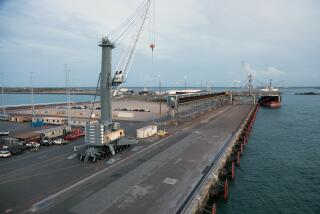Australia’s Support for E. Timor Rooted in Guilt : Military: Sending troops to the territory is popular in the country and seen as a way to make amends for past indifference.
- Share via
DARWIN, Australia — In leading a peacekeeping force to rescue East Timor from the ravages of anarchy, Australia is repaying a 57-year-old debt to a people who provided this nation with heroic support during World War II--and then were largely abandoned.
The ties date back to 1942, when Australia covertly inserted a guerrilla force into East Timor to harass Japanese bombers that struck Darwin 64 times during the war, killing 264 people and forcing the evacuation of the city’s civilian population. The small Australian unit reportedly killed more than 1,000 Japanese while suffering relatively few casualties.
But the East Timorese--who, at great personal risk, provided the Australians with shelter, intelligence and supplies, and in some cases supported them in combat--paid dearly when the Australians quietly withdrew. As many as 60,000 died at the hands of the Japanese.
A country where friendship is a creed of life, Australia has long been haunted by a sense of guilt for its treatment of the East Timorese then and in succeeding years. The government here followed an unofficial “white Australia” policy until the early 1970s, generally denying even tourist visas to East Timorese and other Asians. And Australia deserted the East Timorese in their hour of gravest need: the 1975 invasion by Indonesia, which has ruled the territory since.
Australia, along with the United States, gave a subtle nod of approval to the invasion. A year later, wanting to curry favor with the government of Indonesian President Suharto, Australia became the first country to recognize the annexation. More than 200,000 East Timorese died of starvation, warfare and torture in the decades that followed.
“A lot of us have felt the guilt,” said Don Graham, a Darwin businessman. “I, for one, am glad we’re finally evening accounts. I think most Australians feel that way, and that’s one of the reasons the peacekeeping mission has been supported so enthusiastically.”
Indeed, Australia’s outpouring of support for the East Timor peacekeeping mission is reminiscent of the United States’ flag-waving embrace of American troops who fought Operation Desert Storm in the Persian Gulf in 1991.
Polls show that more than 72% of Australians approve of sending troops to restore order in the former Portuguese colony. There have been almost daily rallies--including the biggest in Darwin since the Vietnam War--to protest the killings and looting carried out in East Timor by Indonesian-backed anti-independence militias. Indonesian consulates have been stoned and Indonesian flags burned.
The Defense Ministry, responding to “unprecedented demand,” has set up an electronic mailbox where Australians can “praise a peacekeeper.” Scores of schools have started letter-writing campaigns to “diggers”--Australian soldiers--now in East Timor. Australian newspapers are each running seven or eight stories a day on the peacekeeping force, which Australia is leading. And Australia will supply 4,500 of the 7,500 peacekeepers who eventually will be on the ground.
In East Timor early today, men and materiel continued to pour into the territorial capital, Dili, on ships and planes. About 3,000 peacekeepers are expected to be on the ground by today.
The peacekeepers have met no resistance since Operation Stabilize began Monday. But journalist Sander Thoenes, a Dutch national working for Britain’s Financial Times, was found dead after being reported missing, officials said.
Maj. Gen. Peter Cosgrove, the Australian who commands the force, said it will be weeks before his troops can take full control.
Thousands of refugees who had camped in the mountains to avoid the marauding militias streamed into Dili seeking food and shelter. Most militiamen, who drove an estimated 200,000 people from their homes in a rampage after East Timorese on Aug. 30 voted overwhelmingly to break away from Indonesia, have withdrawn.
That Australia would make such a significant military commitment to an Asian population reflects the dramatic changes that have swept the country since the days, a generation ago, when Australia was as segregated as pre-Mandela South Africa and Australians spoke openly of the “yellow peril.”
Today Australia is, by design, a multicultural country with a large Asian population. About one-quarter of Darwin’s 80,000 residents are Asian, including 3,000 Timorese. And Australian economic and foreign policy, once inseparable from those of Britain and the United States, increasingly looks to Asia.
The foundation of Australia’s Southeast Asia policy was built on its relationship with Indonesia. With Australia taking the lead in condemning the violence in East Timor, that relationship is so frayed that Indonesian President B. J. Habibie recently refused to take a call from Australian Prime Minister John Howard. The Indonesian government also tore up a 1995 security pact between the two nations, and the 10,000 Australians living in Indonesia have been warned that their security could be in danger.
It is a price Australia appears willing to pay to forge wider and closer bonds in Southeast Asia as a whole and to repay a debt to an impoverished people who offered Australia wartime help while asking little in return.
More to Read
Sign up for Essential California
The most important California stories and recommendations in your inbox every morning.
You may occasionally receive promotional content from the Los Angeles Times.










